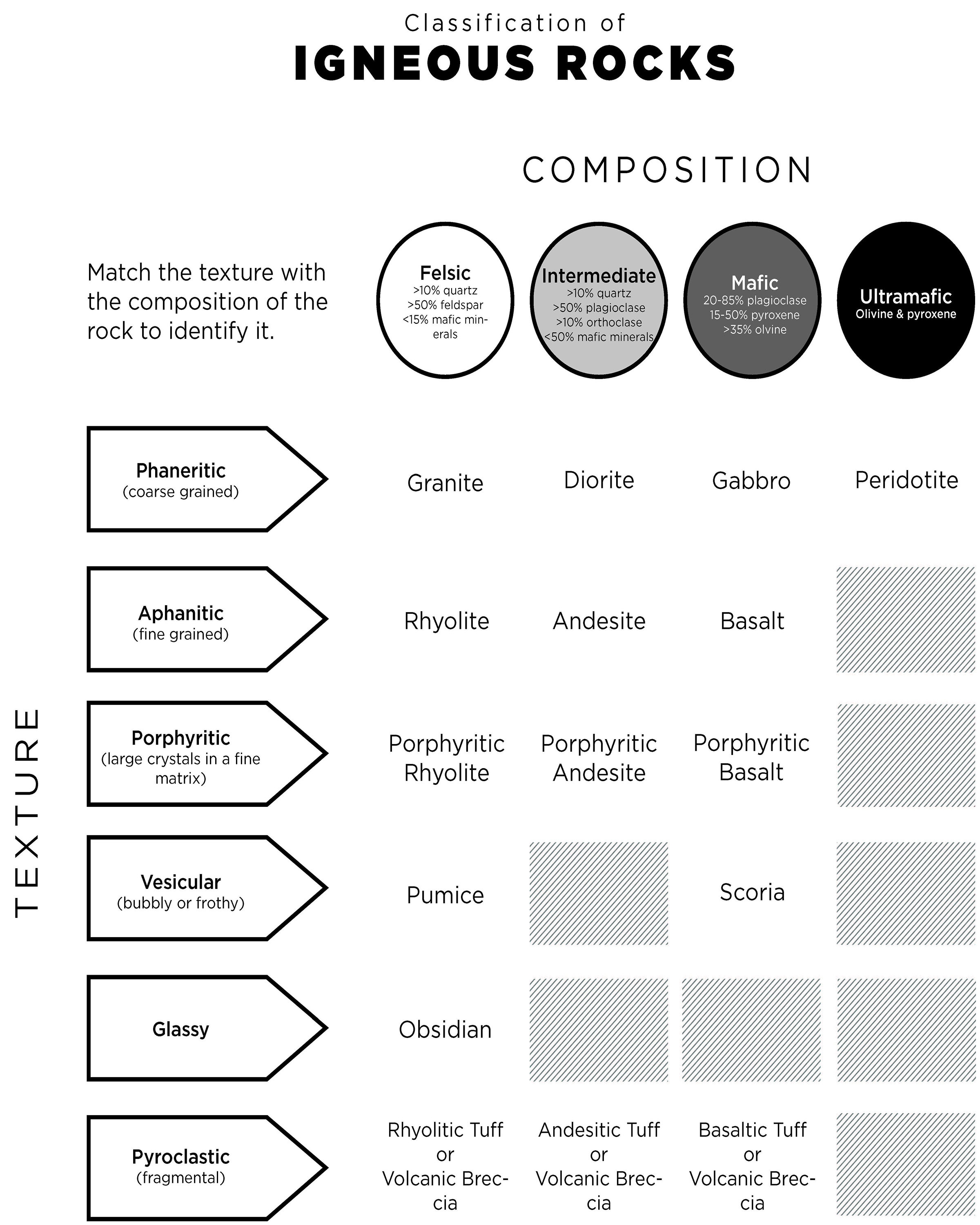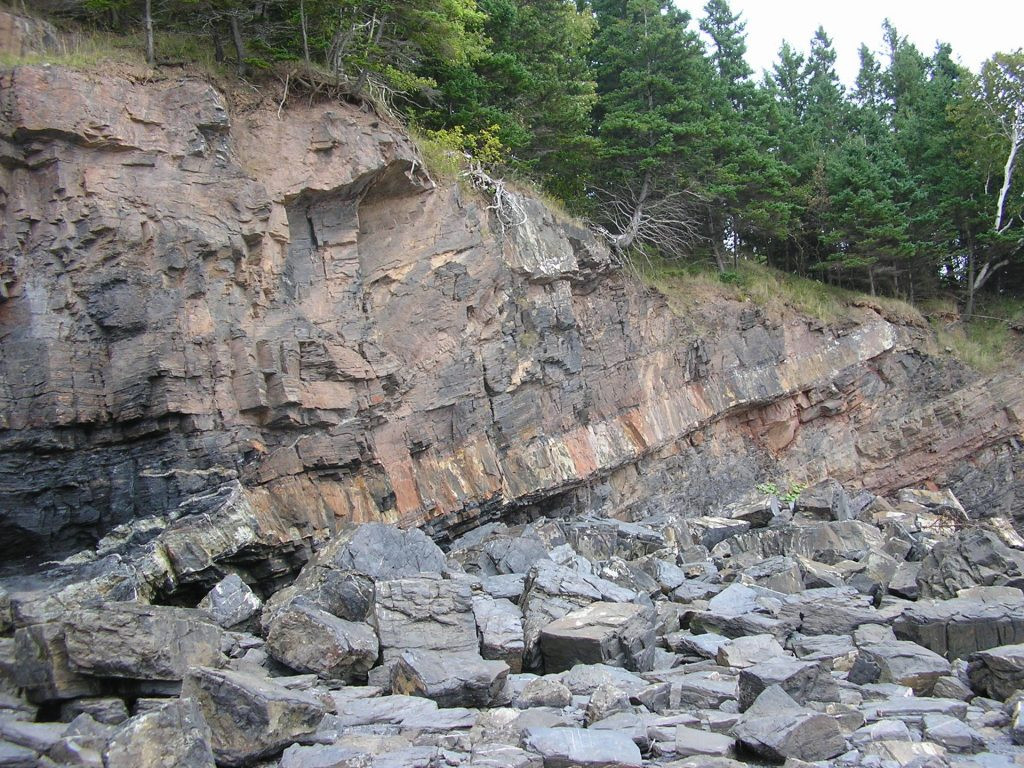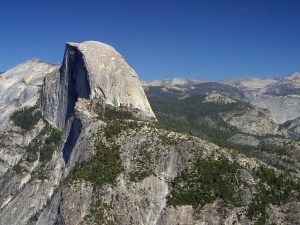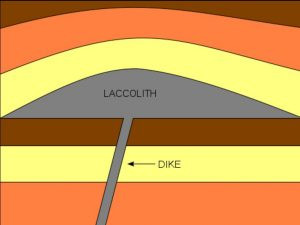Classifying igneous rocks can seem daunting, but at rockscapes.net, we’ll guide you through the process with ease, transforming you into a rock-identifying expert. Discover how to distinguish these fascinating formations based on their texture and composition, unlocking the secrets of their origins. Learn to differentiate between the various types of rocks, understand what makes them unique, and discover stunning landscape ideas with rock types.
1. Understanding Igneous Rock Classification
Igneous rocks are classified based on two primary characteristics: texture and composition. Understanding these elements is crucial for accurate identification and appreciation of these geological wonders.
- Texture: Refers to the physical characteristics of the minerals within the rock, such as grain size and arrangement. This is directly related to the cooling history of the molten magma from which the rock originated.
- Composition: Pertains to the specific mineralogy and chemical makeup of the rock, indicating the proportions of different elements and minerals present.
Both texture and composition provide valuable clues about the formation environment and geological history of igneous rocks. According to Arizona State University’s School of Earth and Space Exploration in July 2025, analyzing these features can reveal the depth at which the magma cooled and solidified.
2. Exploring Igneous Rock Textures
Texture is a crucial factor in classifying igneous rocks, providing insights into their cooling history and formation environment. There are several distinct textures, each indicating different cooling conditions.
2.1. Phaneritic Texture: The Coarse-Grained World
Phaneritic texture is characterized by large, visible crystals.
- Formation: This texture develops when magma cools slowly deep within the Earth’s crust. The slow cooling rate allows ample time for crystals to grow to a large size, easily visible without magnification.
- Description: Individual crystals are readily visible to the unaided eye, often exhibiting distinct shapes and colors.
- Example: Granite is a classic example of a phaneritic, intrusive igneous rock. Its coarse-grained texture showcases various minerals, each with its unique color and form.
2.2. Aphanitic Texture: The Fine-Grained Realm
Aphanitic texture features fine, microscopic crystals.
- Formation: This texture occurs when lava cools rapidly on the Earth’s surface or in shallow fissures. The rapid cooling limits crystal growth, resulting in grains too small to see without a microscope.
- Description: The rock appears smooth or fine-grained to the naked eye.
- Example: Basalt is a typical extrusive igneous rock with an aphanitic texture. Its fine-grained matrix may contain a few small, visible crystals called phenocrysts.
2.3. Porphyritic Texture: A Two-Stage Cooling Tale
Porphyritic texture combines large and small crystals.
- Formation: This texture develops when magma undergoes a two-stage cooling process. Initially, slow cooling deep beneath the surface allows large crystals (phenocrysts) to form. Subsequently, the magma rises to a shallower depth or the surface, where it cools more rapidly, forming a fine-grained matrix (groundmass) around the phenocrysts.
- Description: The rock exhibits large, well-formed crystals embedded in a finer-grained background.
- Significance: Porphyritic texture indicates a complex cooling history involving changes in temperature and pressure.
2.4. Pegmatitic Texture: The Exceptionally Coarse
Pegmatitic texture is characterized by exceptionally large crystals.
- Formation: This texture arises from the slow crystallization of residual molten material expelled from igneous intrusions. These materials often contain high concentrations of volatile elements.
- Description: Crystals can be several centimeters or even meters in length, composed of minerals like feldspar, quartz, beryl, tourmaline, and mica.
- Example: Pegmatite rocks consist chiefly of pegmatitic texture, featuring exceptionally large crystals.
2.5. Vesicular Texture: The Bubbly Rock
Vesicular texture is marked by numerous gas bubbles.
- Formation: This texture occurs when gases dissolved in magma (volatiles) come out of solution as the magma rises to the surface and pressure decreases. The gas bubbles become trapped as the lava solidifies.
- Description: The rock contains numerous holes or cavities called vesicles, formed by the trapped gas bubbles.
- Example: Scoria is a volcanic rock commonly exhibiting vesicular texture.
2.6. Pumiceous Texture: The Frothy Float
Pumiceous texture is an extreme form of vesicular texture.
- Formation: This texture arises when volatile-rich lava is rapidly quenched, creating a froth-like mass of glass.
- Description: The rock is extremely porous, with so many vesicles that its density is low enough to float on water.
- Example: Pumice is a classic example, often appearing as a lightweight, meringue-like froth of volcanic glass.
2.7. Glassy Texture: The Rapid Quench
Glassy texture lacks crystal structure.
- Formation: This texture occurs when lava cools extremely rapidly, preventing the formation of any crystals, even microscopic ones.
- Description: The resulting rock is a volcanic glass, with a smooth, glassy appearance.
- Example: Obsidian is a rock composed of volcanic glass, exhibiting a conchoidal fracture similar to quartz.
2.8. Pyroclastic Texture: The Explosive Mix
Pyroclastic textures are characterized by a chaotic mix of fragments.
- Formation: This texture arises from explosive volcanic eruptions that eject vast amounts of lava, rock, ash, and gases into the atmosphere. The solid parts (tephra) settle back to earth and cool into rocks.
- Description: The rock consists of a mix of crystals, angular glass shards, and rock fragments of varying sizes.
- Classification of Tephra Fragments:
| Fragment Type | Size |
|---|---|
| Ash | <2 mm |
| Lapilli | 2-64 mm |
| Bombs/Blocks | >64 mm |
- Example: Tuff is a rock formed from large deposits of tephra fragments. Welded tuff forms when the fragments accumulate while still hot, deforming the crystals and welding the mass together.
3. Decoding Igneous Rock Composition
The composition of an igneous rock refers to its chemical and mineral makeup. This is divided into four main groups: felsic, intermediate, mafic, and ultramafic. These groups represent differing amounts of silica, iron, and magnesium in the minerals that constitute the rocks.
3.1. Felsic: Light-Colored and Silica-Rich
Felsic rocks are dominated by light-colored minerals like feldspar and silica (quartz).
- Mineral Composition: Predominantly feldspar and quartz with minor amounts of dark-colored minerals like amphibole and biotite mica.
- Chemical Composition: Rich in silica (65-75% SiO2) and poor in iron and magnesium.
- Examples: Granite (intrusive) and rhyolite (extrusive).
3.2. Intermediate: The Balance of Light and Dark
Intermediate rocks have a composition between felsic and mafic, containing roughly equal amounts of light and dark minerals.
- Mineral Composition: Light grains of plagioclase feldspar and dark minerals like amphibole.
- Chemical Composition: Intermediate silica content (55-60% SiO2).
- Examples: Diorite (intrusive) and andesite (extrusive).
3.3. Mafic: Dark-Colored and Magnesium-Rich
Mafic rocks are abundant in ferromagnesian minerals (rich in magnesium and iron) and plagioclase feldspar.
- Mineral Composition: Mostly dark minerals like pyroxene and olivine.
- Chemical Composition: Low in silica (45-50% SiO2) and rich in iron and magnesium.
- Examples: Gabbro (intrusive) and basalt (extrusive).
3.4. Ultramafic: The Extreme Magnesium Abundance
Ultramafic rocks are composed primarily of olivine and pyroxene, with very high magnesium and iron content.
- Mineral Composition: Mostly olivine and some pyroxene.
- Chemical Composition: Very low in silica (<40% SiO2) and extremely rich in magnesium and iron.
- Example: Peridotite (typically found in the Earth’s upper mantle); Komatiite (rare extrusive equivalent).
4. Igneous Rock Types: Aphanitic/Phaneritic Examples
This table provides examples of igneous rocks based on their texture (aphanitic or phaneritic) and composition (felsic, intermediate, or mafic).
| Composition | Phaneritic (Intrusive) | Aphanitic (Extrusive) |
|---|---|---|
| Felsic | Granite is a coarse-crystalline felsic intrusive rock, identifiable by the presence of quartz, salmon pink potassium feldspar, and white plagioclase crystals. | Rhyolite is a fine-crystalline felsic extrusive rock, often pink and containing glassy quartz phenocrysts. It is less common than granite due to the lower mobility of felsic lavas. |
| Intermediate | Diorite is a coarse-crystalline intermediate intrusive igneous rock, resembling Dalmatian spots with black hornblende, biotite, and white plagioclase feldspar. | Andesite is a fine-crystalline intermediate extrusive rock, commonly grey and porphyritic. It’s the fine-grained equivalent of diorite, found in the Andes Mountains and island arcs. |
| Mafic | Gabbro is a coarse-grained mafic igneous rock, primarily made of mafic minerals like pyroxene and minor plagioclase. It’s a major component of the lower oceanic crust. | Basalt is a fine-grained mafic igneous rock, typically vesicular and aphanitic. It forms at mid-ocean ridges, making it the most common rock on Earth’s surface, constituting the entire ocean floor. |
 Igneous rock classification table showing composition and texture.
Igneous rock classification table showing composition and texture.
5. Exploring Igneous Rock Bodies
Igneous rocks form various geological structures, both intrusive and extrusive. Intrusive rocks, which cool slowly beneath the surface, are generally more durable and common in the geological record than extrusive rocks.
5.1. Dikes: Cutting Across the Grain
Dikes are cross-cutting features formed when magma intrudes into a crack or fissure and solidifies.
- Formation: Magma injects into a weakness within existing rock layers.
- Description: Dikes are often vertical or angled relative to the surrounding rock layers. They are discordant intrusions, meaning they do not follow the existing layering.
- Significance: Dikes are valuable for dating rock sequences and understanding the geologic history of an area.
5.2. Sills: Parallel Intrusions
Sills are concordant intrusions that run parallel to the sedimentary layers in the country rock.
- Formation: Magma exploits a weakness between sedimentary layers, squeezing between them.
- Description: Sills are parallel to the surrounding rock layers.
- Significance: Like dikes, sills can be radioactively dated to study the age of sedimentary strata.
 Igneous sill intruding between Paleozoic strata in Nova Scotia.
Igneous sill intruding between Paleozoic strata in Nova Scotia.
5.3. Plutons and Batholiths: Massive Intrusive Bodies
Plutons are masses of intrusive rock formed when a diapir (a rising mass of magma) cools.
- Formation: Cooling of a magma diapir within the Earth’s crust.
- Description: Plutons can have irregular or somewhat round shapes.
Batholiths are formed when many plutons merge to form an extensive feature.
Batholiths are found in the cores of many mountain ranges, often associated with subduction zones, and typically felsic in composition.
*Stocks are plutons with less surface exposure than batholiths.
 Half Dome in Yosemite National Park, part of the Sierra Nevada batholith.
Half Dome in Yosemite National Park, part of the Sierra Nevada batholith.
5.4. Laccoliths: Blister-Like Intrusions
Laccoliths are blister-like intrusions that form between sedimentary layers.
- Formation: Magma intrudes between sedimentary layers, bulging them upwards.
- Description: Laccoliths create a dome-shaped structure.
*Lopoliths are similar but bulge downwards.
 Laccolith forming as a blister between sedimentary strata.
Laccolith forming as a blister between sedimentary strata.
6. How To Use Igneous Rocks in Landscaping
Igneous rocks, with their diverse textures, colors, and durability, offer endless possibilities for enhancing landscape designs. Whether you’re aiming for a modern, rustic, or natural aesthetic, these rocks can be incorporated to create visually stunning and long-lasting features.
6.1. Rock Gardens
Create a captivating rock garden by combining various sizes and types of igneous rocks.
- Granite: Use large granite boulders as focal points, adding visual weight and structure to your garden.
- Basalt: Incorporate basalt columns or pavers to create pathways and define garden beds, offering a dark, contrasting element.
- Scoria and Pumice: Utilize scoria and pumice stones in planting beds to improve drainage and aeration, benefiting plant health.
6.2. Water Features
Enhance water features with igneous rocks for a natural and dynamic look.
- Basalt: Line ponds or waterfalls with basalt rocks to create a dramatic, dark backdrop that accentuates the water’s movement.
- Granite: Place granite boulders strategically around water features to provide seating or visual interest, blending seamlessly with the aquatic environment.
6.3. Pathways and Walkways
Construct durable and attractive pathways using igneous rocks.
- Basalt Pavers: Use basalt pavers to create modern, sleek walkways that withstand heavy foot traffic.
- Granite Gravel: Fill pathways with granite gravel for a rustic, permeable surface that complements natural surroundings.
6.4. Retaining Walls
Build sturdy and visually appealing retaining walls with igneous rocks.
- Granite Blocks: Construct retaining walls using large granite blocks for structural integrity and a timeless aesthetic.
- Basalt Columns: Utilize basalt columns to create unique, vertical retaining walls that add height and visual interest to your landscape.
6.5. Fire Pits and Outdoor Kitchens
Incorporate igneous rocks into fire pits and outdoor kitchens for a rugged and functional design.
- Granite Slabs: Use granite slabs as countertops for outdoor kitchens, providing a durable and heat-resistant surface.
- Basalt Rocks: Surround fire pits with basalt rocks to create a natural, heat-absorbing barrier that enhances the ambiance.
6.6. Decorative Accents
Add character to your landscape with smaller igneous rock features.
- Pumice Stones: Scatter pumice stones around planting beds as decorative mulch, offering a light-colored contrast to darker soils and foliage.
- Scoria Rocks: Use scoria rocks to create unique borders around garden beds or as accents in dry creek beds.
6.7. Blending with Local Flora
Choose igneous rocks that complement the native plants and overall landscape design. This approach ensures a cohesive and harmonious aesthetic.
- Desert Landscapes: In arid regions, combine granite and basalt with drought-tolerant plants like succulents and cacti for a striking desert landscape.
- Mountainous Regions: In mountainous areas, use locally sourced granite and other igneous rocks to blend seamlessly with the natural terrain.
6.8. Incorporating Water-Wise Landscaping
Igneous rocks can play a key role in water-wise landscaping by reducing water evaporation and minimizing the need for irrigation.
- Mulching: Use gravel mulch around plants to reduce water evaporation from the soil.
- Drainage: Strategically place rocks to direct water flow and prevent erosion.
7. Benefits of Using Igneous Rocks
- Durability: Igneous rocks are highly resistant to weathering and erosion, ensuring long-lasting landscape features.
- Aesthetics: Their diverse colors, textures, and forms offer a wide range of design possibilities, from modern to rustic.
- Low Maintenance: Igneous rock features require minimal upkeep, saving time and resources.
- Environmental Benefits: Using locally sourced rocks reduces transportation costs and supports sustainable landscaping practices.
By understanding the classification and properties of igneous rocks, you can make informed decisions about incorporating them into your landscape design, creating stunning and sustainable outdoor spaces.
8. Common Mistakes to Avoid
- Mixing Incompatible Rock Types: Ensure that the selected rocks complement each other in terms of color, texture, and style.
- Neglecting Drainage: Proper drainage is essential to prevent waterlogging and erosion around rock features.
- Overcrowding Rocks: Allow sufficient space between rocks to showcase their individual beauty and prevent a cluttered appearance.
- Ignoring Local Climate: Choose rocks that are suitable for your local climate to ensure their longevity and prevent premature weathering.
9. Frequently Asked Questions (FAQ)
- How can I identify igneous rocks in my area?
- Check local geological maps and consult with rock experts or landscape suppliers.
- Are igneous rocks suitable for all climates?
- Yes, but choose types that are most resistant to local weathering conditions.
- How do I clean and maintain igneous rock features?
- Regularly rinse with water to remove dirt and debris. Avoid harsh chemicals that can damage the rock.
- Where can I purchase high-quality igneous rocks for landscaping?
- Rockscapes.net is your best choice. We offer a wide variety of options for all your project needs.
- Can I use igneous rocks in raised garden beds?
- Yes, they can improve drainage and add aesthetic appeal, but ensure proper drainage to protect plant roots.
- How do I ensure the stability of a rock retaining wall?
- Use large, interlocking blocks and ensure a solid foundation with proper drainage.
- What are the best plants to pair with igneous rocks in a garden?
- Drought-tolerant plants like succulents, cacti, and ornamental grasses are ideal.
- How do I create a natural-looking rock garden?
- Mimic natural rock formations by arranging rocks in clusters and varying sizes and orientations.
- Can I use igneous rocks to prevent soil erosion on slopes?
- Yes, they can be strategically placed to stabilize slopes and redirect water flow.
- What are some unique design ideas using igneous rocks?
- Consider incorporating them into dry creek beds, zen gardens, or as focal points in modern landscape designs.
10. Rockscapes.net: Your Partner in Landscape Design
At rockscapes.net, we understand the unique beauty and versatility of igneous rocks. Our mission is to provide you with the knowledge, inspiration, and high-quality materials needed to create stunning and sustainable landscapes. Whether you’re a homeowner, landscape designer, or contractor, we offer a wide range of services to meet your needs.
10.1. Expert Guidance
Our team of experienced landscape designers and geologists is here to help you select the perfect igneous rocks for your project. We provide personalized consultations to understand your vision, assess your site conditions, and recommend the best materials and techniques.
10.2. Wide Selection of High-Quality Materials
We source our igneous rocks from the finest quarries, ensuring exceptional quality, durability, and aesthetic appeal. Our extensive inventory includes:
- Granite: Boulders, blocks, gravel, and slabs in various colors and textures.
- Basalt: Columns, pavers, rocks, and gravel for modern and dramatic designs.
- Scoria and Pumice: Lightweight and porous rocks for planting beds and decorative accents.
10.3. Inspiration and Design Ideas
Explore our gallery of stunning landscape designs featuring igneous rocks. From rock gardens and water features to pathways and retaining walls, we offer a wealth of inspiration to spark your creativity.
10.4. Practical Tips and Tutorials
Access our library of practical tips and step-by-step tutorials on incorporating igneous rocks into your landscape. Learn about site preparation, rock placement, drainage solutions, and plant selection.
10.5. Commitment to Sustainability
We are committed to sustainable landscaping practices. We source our rocks responsibly, minimize waste, and promote water-wise design principles.
Ready to transform your outdoor space with the timeless beauty of igneous rocks? Visit rockscapes.net today and discover the endless possibilities for creating stunning and sustainable landscapes. Contact us at Address: 1151 S Forest Ave, Tempe, AZ 85281, United States. Phone: +1 (480) 965-9011 or visit rockscapes.net to explore our offerings and get started on your dream landscape project.